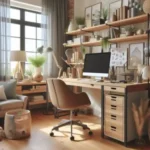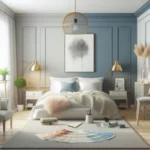As the lines between home and work continue to blur, creating a functional home office has become a necessity for many.
A well-designed workspace not only boosts productivity but also enhances your overall well-being by fostering a sense of balance and comfort. Imagine stepping into a serene environment where every element is thoughtfully curated to support your work habits, from ergonomic furniture to inspiring decor. Whether you’re setting up a cozy nook in your living room or converting a spare bedroom into a full-fledged office, the right design can transform your space into a haven of creativity and efficiency. In this blog post, we will explore ten essential tips for designing your perfect functional home office, offering practical advice and innovative ideas to help you create a workspace that suits your unique style and needs. Get ready to elevate your remote work experience and turn your home office into a space that truly inspires!
1. Assessing Your Needs: Understanding Your Work Style
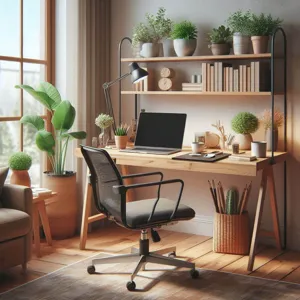
Designing a functional home office starts with a clear understanding of your unique work style and needs. Before you dive into the aesthetics or equipment, take a moment to reflect on how you work best. Are you a creative thinker who thrives in open, collaborative spaces, or do you prefer a quiet, secluded area where you can focus deeply on tasks?
Consider the nature of your work. If your job requires frequent video calls, you’ll need a setup that minimizes distractions and offers a clean background. On the other hand, if you’re a hands-on creator or a meticulous organizer, your office may require ample surface area for projects, as well as storage solutions to keep everything tidy and accessible.
Next, think about your daily routine. Do you work best in short, focused bursts, or do you prefer longer, uninterrupted sessions? This will help determine the type of furniture that suits you—whether it’s a standing desk for those who like to move around or a comfortable ergonomic chair for those who spend hours at their computers.
Don’t forget about the tools and technology that support your workflow. Are there specific software or equipment that you rely on? Make a list of essential items, from monitors and keyboards to notebooks and pens, and envision how they will fit into your space.
By taking the time to assess your needs, you’ll create a home office environment tailored to your work style, enhancing not only your productivity but also your overall comfort and satisfaction while you work. Understanding your workflow is the foundation upon which all other design decisions will be built, ensuring that your home office is as functional as it is inviting.
2. Choosing the Right Location for Your Home Office
Choosing the right location for your home office is one of the most critical decisions you’ll make in creating a functional and inspiring workspace. The location you select can significantly influence your productivity, focus, and overall well-being while working from home.
Begin by assessing your living space. Ideally, your home office should be situated in a quiet area, away from the hustle and bustle of everyday household activities. If you have a spare room, consider transforming it into your office sanctuary. A dedicated space will help you mentally segregate work from personal life, making it easier to switch on and off as needed.
If a separate room isn’t an option, think about carving out a corner in a less-trafficked area of your home, such as a quiet nook in the living room or a bright spot near a window. Natural light can work wonders for your mood and concentration, so try to position your desk near a source of daylight to keep your energy levels up throughout the day.
Consider the proximity to essential resources, too. Ensure your workspace is close to reliable Wi-Fi, power outlets, and any equipment you’ll need, such as printers or scanners. If you anticipate frequent video calls, avoid locations with distracting backgrounds or high foot traffic that could lead to interruptions.
Finally, don’t overlook the importance of ambiance. Choose a location that allows you to personalize your space with decor, plants, or inspiring artwork, creating an environment that fosters creativity and motivation. By thoughtfully selecting the right location for your home office, you can cultivate a space that not only enhances your productivity but also reflects your personal style and comforts.
3. Selecting a Functional Layout: Ergonomics and Flow
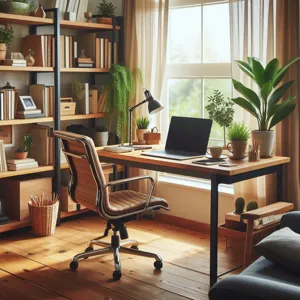
When it comes to creating a functional home office, selecting the right layout is crucial for both productivity and comfort. A well-thought-out design that prioritizes ergonomics and flow can transform your workspace into a haven of efficiency and creativity. Start by assessing the space available to you—consider the size of the room, the placement of windows, and existing furniture.
Begin with your desk, the centerpiece of your office. Ideally, it should be positioned to allow natural light to brighten your workspace while minimizing glare on your screens. An L-shaped desk can be an excellent choice for maximizing corner spaces, offering ample surface area without feeling cramped. Ensure that your chair is adjustable, allowing you to maintain a proper posture with your feet flat on the ground and your arms at a 90-degree angle when typing.
Next, think about the flow of the room. A clutter-free environment is essential for maintaining focus, so strategically arrange your essentials within arm’s reach. Use shelving, storage bins, and organizers to keep your desk tidy, and consider a layout that encourages movement. For instance, place your printer or filing cabinet slightly away from your main work area to create an intentional workflow that requires you to get up occasionally—this not only helps break up long periods of sitting but also encourages a healthy routine.
Finally, don’t forget about the importance of personal touches. Integrate elements like plants, artwork, or motivational quotes to inspire creativity and make your workspace feel inviting. By carefully selecting a layout that combines ergonomics with a seamless flow, you’ll set the stage for a productive and comfortable home office that meets all your functional needs.
4. Essential Furniture: Desks, Chairs, and Storage Solutions
When it comes to designing your perfect functional home office, choosing the right furniture is paramount. The foundation of a productive workspace lies in its essential pieces: desks, chairs, and storage solutions. Each of these elements plays a vital role in not only aesthetic appeal but also in enhancing your workflow and comfort.
**Desks:** The desk is the centerpiece of your home office and should reflect both your personal style and your work needs. Consider the size of your space and choose a desk that fits comfortably without overwhelming the room. A standing desk or an adjustable model can offer versatility, allowing you to switch between sitting and standing throughout the day, which can boost energy levels and reduce the risk of health issues associated with prolonged sitting. Look for a desk with ample surface area to accommodate your computer, documents, and any other tools of your trade, ensuring that everything you need is within arm’s reach.
**Chairs:** Comfort is key when it comes to your office chair. An ergonomic chair is an investment that pays off in the long run by supporting your posture and reducing strain on your back and neck. Look for features such as adjustable height, lumbar support, and breathable materials to keep you comfortable during long hours of work. It’s worth trying out a few options to find the one that fits you best—after all, a happy worker is a productive worker.
**Storage Solutions:** Clutter can be a significant distraction, so implementing effective storage solutions is essential for maintaining an organized workspace. Depending on your needs, consider a combination of shelving units, filing cabinets, and desk organizers. Open shelving can showcase inspiring books or decor while keeping frequently used items easily accessible. On the other hand, closed cabinets can hide away paperwork or office supplies, creating a clean and streamlined look. Don’t underestimate the value of vertical space; wall-mounted storage can maximize your area and keep your desktop free from distractions.
By carefully selecting and arranging these essential pieces of furniture, you can create a home office that not only looks great but also functions seamlessly to support your productivity and creativity. Remember, your workspace should inspire you, so choose furniture that speaks to your style and meets your practical needs!
5. Optimizing Lighting: Natural vs. Artificial Light
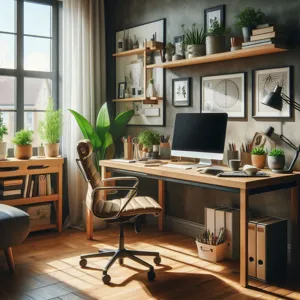
Optimizing lighting is a crucial aspect of creating a functional home office that enhances productivity and comfort. The right balance between natural and artificial light can significantly affect your mood, focus, and overall well-being while you work.
**Natural Light**: Whenever possible, harness the power of natural light. Research has shown that exposure to daylight can improve mood and energy levels, making you feel more alert and engaged. Position your desk near windows to take advantage of sunlight during the day. However, be mindful of glare on your computer screen; using sheer curtains or adjustable blinds can help diffuse harsh light while still allowing the beauty of the outdoors to filter in. Adding plants to your workspace can also enhance the experience of natural light, creating a calming, refreshing atmosphere that promotes creativity and reduces stress.
**Artificial Light**: As the day wanes or on overcast days, having appropriate artificial lighting becomes essential. Opt for a mix of ambient, task, and accent lighting to create a well-rounded environment. A stylish desk lamp with adjustable brightness is ideal for focused tasks, providing direct light for reading or working without straining your eyes. Consider using LED bulbs with a color temperature that mimics daylight—these bulbs can help reduce fatigue, improve concentration, and make your workspace feel more inviting. Additionally, overhead lighting should complement your desk setup; a dimmable ceiling fixture allows you to adjust the brightness to suit your needs throughout the day.
By thoughtfully combining natural and artificial light, you can create a workspace that not only looks beautiful but also supports your productivity and mental clarity. Remember, a well-lit home office is not just about visibility—it’s about crafting an environment that inspires you to thrive.
6. Creating a Distraction-Free Environment
Creating a distraction-free environment is paramount for enhancing productivity in your home office. In our increasingly connected world, distractions lurk around every corner, from the pull of social media notifications to the tempting allure of household chores. To truly maximize your focus, it is essential to cultivate a workspace that minimizes these interruptions and fosters a serene atmosphere conducive to deep work.
Start by choosing a dedicated space that is separate from the hustle and bustle of daily life. This could be a spare room, a corner of your bedroom, or even a nook in the living room—whatever suits your lifestyle best. Once you’ve selected your spot, make a conscious effort to declutter. A clean and organized workspace can significantly impact your mental clarity, allowing you to concentrate fully on the tasks at hand.
Consider the layout of your office as well. Position your desk in a way that limits visual distractions; facing a wall or a window with a view of nature can help keep your focus on your work instead of what’s happening in the rest of the house. If noise is a concern, invest in noise-canceling headphones or a white noise machine to drown out background sounds. Alternatively, you might find that playing soft instrumental music enhances your concentration.
Lighting plays a crucial role in creating a distraction-free environment too. Aim for natural light if possible, as it not only brightens your space but also boosts mood and energy levels. If that’s not viable, opt for warm, adjustable lighting that reduces eye strain and creates a cozy atmosphere.
Finally, put boundaries in place with family or housemates. Communicate your work hours and the importance of minimizing interruptions during these times. Consider using visual cues, like a “do not disturb” sign, to indicate when you are in deep work mode. By establishing a distraction-free environment, you’ll cultivate a sanctuary where creativity and productivity can flourish, bringing you one step closer to achieving your work-from-home goals.
7. Incorporating Technology: Tools and Gadgets for Efficiency
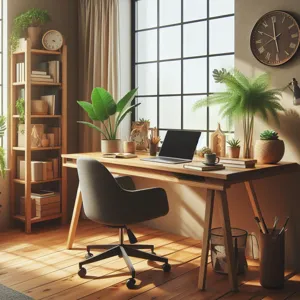
In the modern age, a functional home office is not just about a desk and a chair; it’s about creating an environment that harnesses the power of technology to enhance productivity and streamline your workflow. When designing your perfect home office, incorporating the right tools and gadgets can make all the difference in achieving efficiency and comfort.
Start with a high-quality computer or laptop that meets your specific needs, whether it’s for graphic design, programming, or simple administrative tasks. Pair it with a larger monitor to reduce eye strain and expand your digital workspace, allowing you to multitask with ease. Consider investing in a detachable keyboard and mouse, which can help you maintain an ergonomic setup and create a more flexible work environment.
Don’t overlook the importance of reliable internet access. A high-speed router can eliminate frustrating lag times during video conferences or when uploading large files. For those who thrive on organization, smart storage solutions like digital filing systems or cloud-based applications can help you keep your files accessible yet clutter-free.
In addition to these essentials, think about the little gadgets that can boost your productivity. Noise-canceling headphones can create a focused atmosphere, blocking out distractions and allowing you to concentrate fully on your tasks. A smart speaker or virtual assistant can help manage your schedule, set reminders, and control smart devices in your office, making your workspace even more efficient.
Lighting is another critical aspect of a functional home office. Smart lighting systems can adjust based on the time of day or your specific tasks, helping to reduce eye strain and create a more inspiring work environment. Consider adding plants or digital photo frames that can be controlled via your smartphone; these elements not only personalize your space but also contribute to a more positive and motivating atmosphere.
By thoughtfully incorporating these technological tools and gadgets into your home office design, you can create a space that not only looks good but also works harmoniously with your workflow, setting the stage for ultimate productivity and creativity. Embrace technology as your ally, and watch your home office transform into the efficient workspace you’ve always dreamed of.
8. Personalizing Your Space: Decor and Inspiration
Creating a home office that reflects your personality is essential for fostering creativity and productivity. Personalizing your space goes beyond simply choosing a desk and chair; it involves curating an environment that inspires you every day. Start by selecting a color palette that resonates with you—soft pastels can evoke calmness, while bold hues might energize and stimulate your creativity.
Incorporate decor that speaks to your interests and passions. Think about displaying artwork that inspires you, whether it’s a striking painting, motivational quotes, or photographs of cherished moments. Consider adding a vision board where you can pin images, articles, and goals that motivate you. This tactile representation of your aspirations can serve as a daily reminder of what drives you.
Plants can also play a pivotal role in personalizing your office. Not only do they add a touch of nature, but studies show that greenery can enhance mood and productivity. Choose low-maintenance plants like succulents or pothos if you’re concerned about upkeep, or opt for larger leafy varieties for a more substantial impact.
Make sure to include elements that cater to your comfort and workflow. A cozy throw blanket draped over your chair, a cup that holds your favorite pens, or a scented candle can transform your workspace into a haven. Additionally, keep an eye on ergonomics; personalized adjustments like a standing desk or a chair with lumbar support can enhance your comfort and focus.
Finally, don’t forget about organization. Utilize stylish storage solutions—think decorative boxes or artistic shelves—to keep clutter at bay while still expressing your unique style. By thoughtfully personalizing your home office with decor that inspires and comforts you, you’ll create a functional space that not only looks good but feels good to work in.
9. Designing for Comfort: Temperature and Acoustics
When it comes to creating the perfect functional home office, comfort should be at the forefront of your design considerations. Two critical elements that significantly impact your workspace’s comfort level are temperature and acoustics.
**Temperature** plays a pivotal role in your ability to focus and maintain productivity. An overly hot or cold environment can lead to distractions and discomfort, ultimately hindering your work performance. Aim for a temperature range between 68°F and 72°F (20°C to 22°C), which is generally considered ideal for most people. Consider investing in a programmable thermostat that allows you to adjust the temperature based on your daily schedule, ensuring a consistently pleasant work environment. Additionally, utilizing fans or space heaters can provide localized comfort without needing to alter the entire home’s climate.
**Acoustics** are equally important in fostering a conducive working atmosphere. Noise pollution from outside can easily disrupt your concentration and diminish your productivity. To address this, assess the acoustics of your home office space and explore options for soundproofing. Adding heavy curtains, rugs, or acoustic panels can absorb sound and reduce echoes, creating a quieter, more serene environment. Moreover, consider incorporating white noise machines or soft background music to mask distracting sounds and help you maintain focus.
By carefully curating the temperature and soundscape of your home office, you can create a space where comfort reigns supreme, making it easier for you to dive into your work and remain engaged throughout the day. Remember, a comfortable environment is not just about aesthetics but also about enhancing your overall efficiency and well-being as you navigate your professional tasks.
10. Organizing Your Workspace: Decluttering and Maintenance
A well-organized workspace is crucial for maintaining productivity and fostering creativity, especially in a home office environment where distractions can easily creep in. Decluttering is the first step in this process; it involves not just tidying up your physical space but also creating a system that allows for efficient workflow. Begin by evaluating your desk and surrounding areas: remove any items that do not serve a distinct purpose or that you haven’t used in the last few months. Consider adopting a minimalist approach—less is often more when it comes to creating an environment that feels open and inspiring.
Once you’ve decluttered, it’s essential to implement a maintenance routine to keep your workspace in optimal condition. Set aside time at the end of each week to reassess your organization. Ask yourself if there are new items that need a designated space or if there are still items lingering that could be discarded or donated. Invest in storage solutions that suit your style—whether it be sleek, modern shelving or charming, rustic bins—to keep essential documents and supplies within reach yet out of sight.
Additionally, don’t forget to organize your digital workspace. Regularly declutter your computer files and emails to prevent digital overload. Create folders for different projects and set reminders to back up important documents—this not only saves you time but also reduces stress.
By prioritizing decluttering and maintenance, you create a sanctuary of productivity that allows you to focus on your work without the mental burden of chaos. An organized workspace is more than just visually appealing; it’s a critical element in boosting your efficiency and effectiveness in your home office. Embrace the peace that comes from a clean and orderly environment, and watch your productivity soar!
11. Balancing Aesthetics and Functionality
When designing your perfect functional home office, finding the sweet spot between aesthetics and functionality is key to creating an environment that inspires productivity while also reflecting your personal style. A beautifully designed space can enhance your mood and motivation, but if it lacks the necessary elements for effective work, it can quickly become a source of frustration.
Start by selecting a color palette that resonates with you and promotes focus. Soft, neutral tones can create a calming atmosphere, while pops of vibrant colors can invigorate your creativity. Consider incorporating artwork or decorative elements that inspire you—these can serve as visual reminders of your goals and aspirations.
However, aesthetics shouldn’t come at the expense of functionality. Choose furniture that not only looks good but also supports your workflow. An ergonomic chair and a spacious desk are essential for comfort during long working hours. Ensure that your layout promotes easy movement and access to essential tools, like your computer, printer, and reference materials.
Lighting is another critical consideration; a well-lit space can significantly impact your productivity. Natural light is ideal, so position your desk near a window if possible. Complement this with adjustable task lighting that can help reduce eye strain during evening hours.
Lastly, don’t forget about organization. A clutter-free space enhances both aesthetics and functionality. Invest in stylish storage solutions—like decorative baskets, shelving, and filing systems—that keep your workspace tidy while adding to the overall design.
By striking this balance between beauty and usability, you can create a home office that not only looks inviting but also supports your work habits, making it a space you’ll love spending time in every day.
12. Setting Boundaries: Defining Work-Life Separation
Creating a functional home office goes beyond just choosing the right desk or finding the perfect ergonomic chair; it also involves establishing clear boundaries to demarcate your work life from your personal life. In the fluid environment of remote work, where the lines between professional and personal spaces can easily blur, setting these boundaries is essential for maintaining productivity and mental well-being.
Start by designating a specific area in your home exclusively for work. This doesn’t have to be an entire room; it could simply be a corner of your living room or a nook in your bedroom. The key is to make this space distinct and recognizable as your workspace. Use physical markers, such as a room divider or even a simple curtain, to separate your office area from other living spaces. This visual cue can help signal to both you and your family when you are “at work” and when you are available for personal interactions.
Next, establish a consistent work schedule. Communicate your working hours to those you live with, so they understand when you should not be disturbed. By adhering to a routine, you not only foster a sense of professionalism but also create a rhythm that helps you transition into and out of work mode. Consider using a timer or a digital calendar to structure your day, allowing for breaks and personal time that can rejuvenate your focus.
In addition to physical separation and scheduling, consider implementing digital boundaries. For example, try to keep your work-related apps and files organized in a dedicated section of your devices, separate from personal content. Turn off work notifications outside of your designated hours, allowing you to fully engage in your personal life without the distractions of emails and messages.
Finally, be mindful of your mental space. Address the emotional aspects of working from home by creating rituals that help you switch between work and personal life. This could be as simple as a short walk after work hours, a brief meditation session, or even a specific playlist that signals the end of your workday. By consciously defining these boundaries, you not only enhance your productivity but also create a healthier work-life balance that nurtures both your career and your personal happiness.
13. Tips for Maintaining Productivity in Your Home Office
Maintaining productivity in your home office can be a challenging task, especially with the myriad of distractions that come with working from home. However, with the right strategies in place, you can create an environment that fosters focus and efficiency. Here are some essential tips to help you stay productive throughout your workday.
First and foremost, establish a dedicated workspace that is free from distractions. Whether it’s a separate room or a well-defined corner in your living space, having a designated area for work signals to your brain that it’s time to focus. Personalize this space with inspiring decor, but keep it clutter-free to minimize distractions.
Next, establish a consistent daily routine. Set regular start and end times for your workday, just as you would in a traditional office. This routine helps create a sense of structure and discipline, making it easier to transition into a productive mindset. Incorporate short breaks to recharge—consider the Pomodoro Technique, which involves working in focused bursts followed by brief breaks to maintain energy levels.
Additionally, leverage technology to your advantage. Use productivity apps and tools to keep your tasks organized and prioritize your workload. Tools like Trello or Asana can help you track your projects, while time management apps like Toggl can assist in monitoring how you spend your working hours.
Furthermore, consider your physical well-being. Invest in an ergonomic chair and desk setup to support your posture during long hours of work. Staying hydrated and incorporating movement into your day—be it through stretching, quick workouts, or a brisk walk—also plays a crucial role in maintaining your energy and focus.
Lastly, limit digital distractions by creating a focused work environment. Silence non-essential notifications on your phone and computer, and consider using website blockers to prevent you from straying into social media or other distracting sites during work hours.
By implementing these tips, you can cultivate a home office that not only supports your productivity but also contributes to your overall well-being. Remember, a well-structured and thoughtfully designed workspace is key to achieving your work-from-home goals.
14. Adapting Your Space for Future Needs
As you design your perfect functional home office, it’s crucial to adopt a forward-thinking approach that prepares your workspace for future needs. The nature of work is evolving, and the demands placed on your home office may shift over time due to changes in your job responsibilities, personal interests, or even technological advancements.
Start by considering flexible furniture options that can adapt to varying tasks. For instance, an adjustable desk can easily switch between sitting and standing positions, promoting healthier work habits while accommodating different workflows. Additionally, multipurpose storage solutions, such as modular shelving or mobile carts, allow you to reorganize your space as your needs change without the hassle of a complete redesign.
Think about incorporating technology that can grow with you. Investing in a robust Wi-Fi system and versatile power outlets will ensure that your office can support the latest gadgets as they emerge. Furthermore, consider integrating smart home features, like voice-activated assistants or automated lighting, which can enhance efficiency and streamline your workspace.
Don’t forget the importance of personalization. As your career progresses and your interests evolve, your home office should reflect who you are. Leaving space for personal touches—like art, photographs, or inspirational quotes—can help create an atmosphere that motivates and inspires you, making it easy to update your space as your style and preferences change.
Finally, maintain a mindset of adaptability. Regularly assess your office setup and be open to making changes, whether that’s rearranging furniture for a fresh perspective or updating your decor to keep the environment stimulating. By planning for future needs today, you can create a home office that not only meets your current requirements but also evolves seamlessly with you over time.
15. Final Touches: Adding Personal and Motivational Elements
Creating a functional home office goes beyond just setting up a desk and chair; it’s also about infusing your workspace with elements that inspire and motivate you. Final touches can transform a sterile workspace into a personal sanctuary, making it a place where creativity flows and productivity thrives.
Start by adding personal items that reflect your individuality. This could be a collection of framed photographs featuring cherished moments with family and friends, or artwork that resonates with your personality—a vibrant painting, a motivational poster, or even a vision board that keeps your goals front and center. Each piece should evoke positive emotions, reminding you of your aspirations and the life you’re building.
Incorporate motivational quotes or affirmations in your decor. Whether displayed on a corkboard, printed on a wall, or even as a screensaver on your computer, these reminders can uplift your spirits during challenging days. Choose words that resonate deeply with you—phrases that remind you of your ambitions or the reasons you chose to work from home.
Don’t forget about the role of plants in your workspace. Bringing in a touch of nature not only enhances the aesthetic appeal but also boosts your mood and productivity. Consider low-maintenance options like succulents or snake plants, which can thrive in various lighting conditions. The presence of greenery can create a calming atmosphere, reducing stress and improving focus.
Finally, personalize your workspace with items that enhance your comfort and well-being. Whether it’s a cozy throw blanket draped over your chair, an aromatic diffuser with your favorite essential oils, or even a custom mug for your morning coffee, these small touches can make a significant difference in how you feel in your workspace.
By thoughtfully curating these personal and motivational elements, you’ll not only create a visually appealing environment but also foster a sense of belonging and inspiration that encourages you to bring your best self to your work each day. Your home office should be more than just a place to work; it should be a reflection of you, designed to inspire and energize as you navigate your professional journey.
In conclusion, crafting your perfect functional home office is not just about aesthetics; it’s about creating an environment that fosters productivity, creativity, and comfort. By implementing the ten essential tips outlined in this post, you can transform any space into a seamless blend of style and functionality tailored to your unique needs. From optimizing your layout and selecting ergonomic furniture to incorporating personal touches that inspire you, every detail matters in enhancing your work experience. As you embark on this journey, remember that your home office should reflect who you are while facilitating your professional goals. We’d love to hear about your own home office design experiences, so feel free to share your photos and ideas in the comments below! Happy designing!


